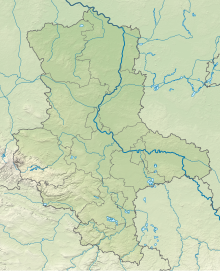Elsholzwiesen
Coordinates: 52 ° 29 ′ 50 ″ N , 11 ° 55 ′ 51 ″ E
The Elsholzwiesen are a nature reserve in the city of Tangermünde in the Stendal district in Saxony-Anhalt .
The nature reserve with the registration number NSG 0193 is around 161 hectares . It is partially a component of the FFH area "Elbaue between Derben and Schoenhausen" and the EU bird sanctuary "Elbaue Jerichow" and mostly from the conservation area surrounded "Tanger-Elbe valley". The area has been under protection since 2000 (date of regulation: June 15, 2000). The responsible lower nature conservation authority is the district of Stendal.
The nature reserve is located south of Tangermünde between the districts of Bölsdorf and Buch in the Middle Elbe Biosphere Reserve . It represents a completely silted oxbow lake in the Altaue the same under protection. The Altaue is separated from the river dynamics by the Elbe dike, but here it is temporarily flooded by high pressure and groundwater as well as in the course of rewetting measures.
The area is a meadow complex with grassland and wet grassland of varying intensity of use. Sometimes there are still Silgen grass curls that were once typical of the natural area. In some wet depressions grow reed canary grass - and water vapors reedbeds. The meadow complex is drained to Tangier via numerous ditches . The banks of the trenches of reeds reeds and banks Staudenfluren taken. Artificially created, stagnant ponds can be found in three places .
Characteristic plant species in the nature reserve are yellow meadow rue , buttercups , marsh hairs , frog bites and bank sedge . Furthermore, u. a. Fox sedge , swamp water star , water feather , meadow sage , tall violet and umbel can be found. The pit violet is a specialty .
The meadow complex is a habitat for numerous animal species. So come here u. a. various birds such as white stork , curlew , black godwit , snipe , corncrake , pintail , teal duck , gadfly , red kite , little owl , meadow pipit , barn warbler , brown and stonechat . The reeds along the trenches are habitat for reed bunting , swamp warbler and pond warbler . The little ringed plover is also native to the nature reserve. Continue to live in the trenches and still waters various amphibians , including toad , grass and moor frog , pond and great crested newt , too, but spadefoot , toad , natterjack toad , green frog and fire-bellied toad and various dragonflies . Also locusts as the Marsh Grasshopper are native.
The meadows are grazed with domestic water buffalo for maintenance . At the edge of the nature reserve there is an observation tower from which the meadow landscape can be viewed. The nature reserve borders mainly on agricultural areas . In the west it borders in parts on a state road , in the east on the Flothgraben (also known as Laufgraben or Bucher Laufgraben). Several amphibious tunnels were built in the course of the state road in summer 2011 as a crossing aid .
Web links
Individual evidence
- ↑ a b c 16 Toad Tunnel on 600 meters of road length , Volksstimme (Elb-Havel-Echo), July 14, 2011. Accessed on May 8, 2014.
- ^ House water buffalo , NABU Elbe Center. Retrieved May 8, 2014.
- ↑ Wilderness on the Elbe , NABU district association Stendal. Retrieved May 8, 2014.


